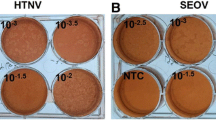Summary
The 76–118 strain of Hantaan virus was titrated in E6 (Vero) cells by the plaque method using agarose overlay medium. Visible plaques, formed 10 days post-infection, were uniformly 2–3 mm in diameter. Dose-response experiments showed that a single infectious particle initiated the formation of a plaque. Infectivity titers by the plaque method were equivalent to those obtained by the endpoint method (TCID50) using the immunofluorescence antibody technique (IFA) for antigen detection. The single-cycle growth pattern of the virus showed an eclipse phase of 7 to 9 hours, with production of cell-free infectious virus 18 hours post-infection. Plaque reduction neutralization tests suggested that complement enhanced the neutralizing activity of sera; rat sera were particularly complement-dependent. The plaque reduction neutralization test was about 10 times more sensitive than the TCID50 neutralization test. Convalescent phase sera from patients with hemorrhagic fever with renal syndrome (HFRS) having higher IF antibody titers to Hantaan virus than to nephropathia epidemica (NE) virus were capable of neutralizing Hantaan virus, while sera from patients with higher IF antibody titers to NE virus than Hantaan virus did not contain neutralizing antibody to Hantaan virus.
Similar content being viewed by others
References
Lee, H. W., Lee, P. W., Johnson, K. M.: Isolation of the etiologic agent of Korean hemorrhagic fever. J. Infect. Dis.137, 298–308 (1978).
Lee, P. W., Amyx, H. L., Gibbs, C.J., jr., Gajdusek, D. C., Lee, H. W.: Propagation of Korean hemorrhagic fever virus in laboratory rats. Infect. Immun.31, 334–338 (1981).
Tsai, T. F., Bauer, S., McCormick, J. B., Kurata, T.: Intracerebral inoculation of suckling mice with Hantaan virus (Letter). Lancet2, 503–504 (1982).
French, G. R., Foulke, R. S., Brand, O. A., Eddy, G. A., Lee, H. W., Lee, P. W.: Korean hemorrhagic fever: propagation of the etiologic agent in a cell line of human origin. Science211, 1046–1048 (1981).
McCormick, J. B., Sasso, D. R., Palmer, E. L., Kiley, M. P.: Morphological identification of the agent of Korean hemorrhagic fever (Hantaan virus) as a member of the Bunyaviridae. Lancet1, 765–768 (1982).
Svedmyr, A., Lee, P. W., Gajdusek, D. C., Gibbs, C. J., jr., Nystrom, K.: Antigenic differentiation of the viruses causing Korean hemorrhagic fever and epidemic (endemic) nephropathy of Scandinavia (Letter). Lancet2, 315–316 (1980).
Gibbs, C. J., jr., Takenaka, A., Franko, M., Gajdusek, D. C., Griffin, M. D., Chields, J., Korch, G. W., Wartzok, D.: Seroepidemiology of Hantaan virus (Letter). Lancet2, 1406–1407 (1982).
Reed, L. J., Muench, H.: A simple method for estimating fifty percent endpoints. Am. J. Hyg.27, 493–497 (1938).
Lee, P. W., Amyx, H. L., Gajdusek, D. C., Yanagihara, R. T., Goldgaber, D., Gibbs, C. J., jr.: New hemorrhagic fever with renal syndrome-related virus in indigenous wild rodents in United States (Letter). Lancet2, 1045 (1982).
Karber, F.: Beitrag zur kollektiven Behandlung pharmakologischer Reihenversuche. Arch. Exp. Pathol. Pharmakol.162, 480–483 (1931).
Schmaljohn, C. S., Hasty, S. E., Harrison, S. A., Dalrymple, J. M.: Characterization of Hantaan virions, the prototype virus of hemorrhagic fever with renal syndrome. J. Infect. Dis.148, 1005–1012 (1983).
Schmaljohn, C. S., Dalrymple, J. M.: Analysis of Hantaan virus RNA: evidence for a new genus of Bunyaviridae. Virology131, 482–491 (1983).
McCormick, J. B., Sasso, D. R., Palmer, E. L., Kiley, M. P.: Morphological identification of the agent of Korean hemorrhagic fever (Hantaan virus) as a member of the Bunyaviridae. Lancet1, 765–768 (1982).
White, J. D., Shirey, F. G., French, G. R., Huggins, J. W., Brand, O. M., Lee, H. W.: Hantaan virus, etiological agent of Korean hemorrhagic fever, has Bunyaviridae-like morphology. Lancet1, 768–771 (1982).
Schmaljohn, C. S., Dalrymple, J. M.: In:Bishop, D. H. L., Compons, R. W. (eds.), Segmented Negative Strand Viruses, Vol. 2. New York: Academic Press 1984.
Schmaljohn, C. S., Hasty, S. E., Dalrymple, J. M., LeDuc, J. W., Lee, H. W., von Bonsdorff, C. H., Brummer-Korvenkontio, M., Vaheri, A., Tsai, T. F., Regnery, H. L., Goldgaber, D., Lee, P. W.: Antigenic and genetic properties place viruses linked to hemorrhagic fever with renal syndrome into a newly defined genus of Bunyaviridae. Nature (in press, 1985).
Lee, H. W.: Korean hemorrhagic fever. Prog. Med. Virol.28, 96–113 (1982).
Cooper, P. D.: The plaque assay of animal viruses. In:Maramorosch, K., Koprowski, K. (eds.), Methods in Virology, Vol. 3, 243–311. New York: Academic Press 1967.
Song, G., Hang, C.-S., Qui, X.-Z., Ni, D.-S., Liao, H.-X., Gao, G.-Z., Du, Y.-L., Xu, J.-K., Wu, Y.-S., Zhao, J.-N., Kong, B.-X., Wang, Z.-S., Zhang, Z.-Q., Shen, H.-K., Zhou, N.: Etiologic studies of epidemic hemorrhagic fever (hemorrhagic fever with renal syndrome). J. Infect. Dis.147, 654–659 (1983).
Kitamura, T., Morita, C., Komatsu, T., Sugiyama, K., Arikawas, J., Shiga, S., Takeda, H., Akao, Y., Imaizumi, K., Oya, A., Hashimoto, N., Urasawa, S.: Isolation of virus causing hemorrhagic fever with renal syndrome (HFRS) through a cell culture system. Jpn. J. Med. Sci. Biol.36, 17–25 (1983).
Tsai, T. F., Bauer, S. P., McCormick, J. B., Kurata, T.: Serologic and virologic evidence of Hantaan-related enzoosis in the United States. In: Abstracts of the First International Symposium on Public Health in Asis and the Pacific Basin, Honolulu, Hawaii, 1983.
Gajdusek, D. C.: Muroid virus nephropathies and muroid viruses of the Hantaan virus group. Scand. J. Infect. Dis.36, Suppl., 96–118 (1982).
Author information
Authors and Affiliations
Additional information
With 3 Figures
On leave from the Department of Virology, Kyushu University School of Medicine, Fukuoka 812, Japan.
Rights and permissions
About this article
Cite this article
Takenaka, A., Gibbs, C.J. & Gajdusek, D.C. Antiviral neutralizing antibody to Hantaan virus as determined by plaque reduction technique. Archives of Virology 84, 197–206 (1985). https://doi.org/10.1007/BF01378972
Received:
Accepted:
Issue Date:
DOI: https://doi.org/10.1007/BF01378972




